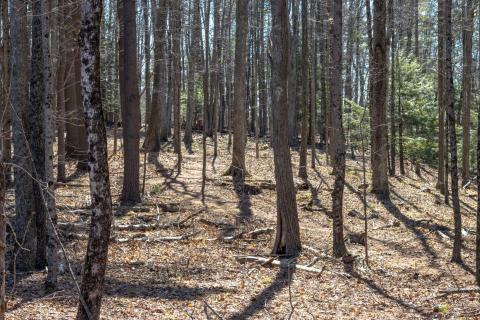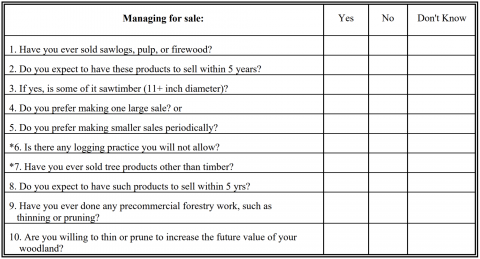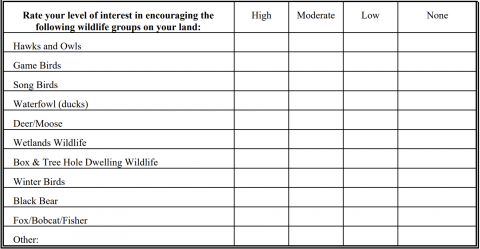
This form is intended to be used by forest landowners who want to develop a forest stewardship plan. Your forest stewardship plan considers the natural resources on your property and your goals and objectives.
Filling out this form will help clarify your desires for your land and will provide your forester the information needed to develop a long term plan to help you realize your goals. Fill this out before or during a meeting with your forester. Contact your county forester to set up a woodlot visit today!
Landowner Goals and Objectives (long version)
Name: _____________________________________________
Date: _____________________________________________
Property Location: __________________________________
Property Size: _____________________________________
Place check-marks in the table below and fill out parts II through IV. Then, for each goal/use that you checked as being of some importance, complete the corresponding sections on the following pages.

- How long have you or your family owned this property?
- ________ years.
- How much longer do you expect to own it?
- _______less than 5 yrs.
- _______5-10 yrs.
- _______10-20 yrs.
- _______longer than 20 yrs.
- What are you most likely to eventually to do with this property?
- ______ sell it
- ______ leave to family
- ______ give to conservation organization
- ______ permanently protect from development
- ______ other:____________________________________________
- Do you live on your property?
- ______ year round
- ______ part time
- ______ not at all
- Do you plan to build on your property?
- ______ within 5 yrs.
- ______ within 10 yrs.
- ______ no plans to build
- Are any public uses of your property restricted?
- ______ yes
- explain:______________________
- ______ no.
- ______ yes
- Days of free labor (self, family, friends): ____ days.
- Percent of earnings from your woodland you are willing to put back into non-income producing natural resource improvements:
- ______ none
- ______ 10%
- ______ 20%
- ______ 30%
- ______ 40%
- ______ 50%
- ______ Other
- Money you are willing to spend out of pocket, if required, on natural resource improvements:
- _____ none
- _____ $100
- _____ $500
- _____ $1000
- _____ Other
- Tools and equipment that you own, can borrow, or rent and can operate:
- Tractor. Describe: ___________________________________
- Tractor implements. List:_____________________________
- Truck. Describe: ____________________________________
- Chain saw: __________________
- Axe, other woods hand tools. List: _______________
- Other. List: _______________________________________________
- Property map, survey notes, air photos, etc. List:___________________
List any circumstances or opinions toward particular kinds of management that may limit activities on your land. __________________________________________________________________________________________________________________ __________________________________________________________________________________________________________________
COMPLETE THOSE SECTIONS BELOW THAT YOU CHECKED AS BEING OF SOME IMPORTANCE IN SECTION I.
How much income do you expect or want from your land in the future? __________________________________________________________________ _____________________________________________________________________________________________________________________________
What types of activities do you expect will generate this income? (ie. selling wood or gravel; user fees; crop production; etc.) _____________________________________________________________________________________________________________________________ _____________________________________________________________________________________________________________________________
This section directly concerns the time that you, your family and your visitors spend and wish to spend in recreation on your land. It indirectly concerns the recreational resources of your land; water and wildlife for example.

* Explain:
________________________________________________________________________________________________________________________
________________________________________________________________________________________________________________________
This section is to help determine your feelings and concerns as well as recognize opportunities for management of the scenic beauty of your property. Scenic beauty relates to specific features such as views, trees or stands with unique character, canopy effects along a trail or road, or perhaps the ability to view into a stand. Scenic beauty may also relate to the combined effects of different communities, such as open fields, softwood and hardwood stands, and the creation of different age classes or heights in trees.
- How important was scenic beauty when you originally purchased this property?
- ______ High
- ______ Low
- ______ Not important
- How important is it to you now?
- ______ High
- ______ Low
- ______ Not important
- Do you have a preference for treating the residue (slash) created by harvesting?
- ____ No preference
- ____ Complete removal
- ____ Lop and Scatter
- ____Chipping
- What approach do you prefer for maintaining openings and vistas?
- ______ Mowing
- ______ Brushing
- ______ Herbicides
On a map of your property, mark and label (ie. PV1, PV2, etc.) the approximate location of any of the following types of features or views (include arrow direction of view) that are important to you. Briefly describe below what you would like done with each (such as: create or open up view; maintain as is; let it grow; change in some way, etc.)
Mark on the map:
EV - Existing view (on or off property)
PV - Potential views
UV - Undesirable views
SF - Special vegetative features (ie. canopy effects, fall color, open areas, old growth, etc.)
UC - Trees with unique character (ie. majestic, unusual branching, etc.)
CF - Cultural features (ie. stone walls, fences, old buildings, etc.)
____________________________________________________________________________
1.
2.
3.
4.
5.
6.
7.
This section distinguishes between managing wood products for sale and for your own use. If you want to do both, fill out both parts of this form. Other products include fenceposts, Christmas trees, and maple syrup/sugar.

* Explain:
_________________________________________________________________________________________________________________________
_________________________________________________________________________________________________________________________

This section is designed to determine your interest in the wildlife that may live on your land


UNH Cooperative Extension programs and policies are consistent with pertinent Federal and State laws and regulations on non-discrimination regarding age, color, handicap, national origin, race, religion, sex, sexual orientation, or veteran’s status. College of Life Sciences and Agriculture, County Governments, NH Division of Forests and Lands, Department of Resources and Economic Development, NH Fish and Game Department, US Department of Agriculture, Forest Service and U.S. Fish and Wildlife Services cooperating.
Revised August, 2007
